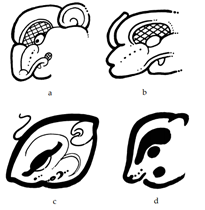
![]()


TOK.p31.r2.c2 K&L.p47.#1.1 K&L.p47.#1.4 [K&L.p47.#1.2&3&5&6 = Zender-TRGiCMW.p6.c1.fig1.a&b&c&d] BMM9.p17.r5.c4
EHM EM(ACH) EM(ACH) EHM

![]()
![]()
Zender-TRGiCMW.p6.c1.fig1. Zender-TRGiCMW.p8.fig4 Zender-TRGiCMW.p9.c1.fig5
a) TRT monument 6 A10a vertical text gb#3 PAL Tablet of the Cross D7-D8
b) TRT monument 6 H10b Blowgunner Pot K1226
c) Black on cream vessel, private collection EHM.<CHAN:na> EHM.<ta:CHAN:na> Palenque-Triad-GI
d) Blowgunner Pot K1226
EHM
· No glyphs given in K&H, K&L.
· Used more often as a rebus for writing ehm(i) = “to descend” (overwhelmingly so) than for the raccoon as an actual animal. The very few occurrences where it doesn’t write “to descend” are in names/titles referring to a raccoon rather than in sentences referring to actual raccoons. This applies to many other words for animals known in Classic Maya: they occur more often in names/titles than as references to the animal in real-life.
· As with many Maya verbs of motion, there is an implicit preposition (in this case “from”):
o Zender-TRGiCMW.p8.fig4 (no explicit preposition): ehm-i chan “descends from the sky”.
o Zender-TRGiCMW.p9.c1.fig5 (with explicit preposition): ehm-i ta chan “Palenque Patron God G1 descends from the sky”.
· Features:
o A mammal head.
o An ear in the top right corner, but not a standard mammal ear, more like a feeler with protector, somewhat resembling the inner element of yi.
o A longish nose, a row of dots forming a spine or reinforcement.